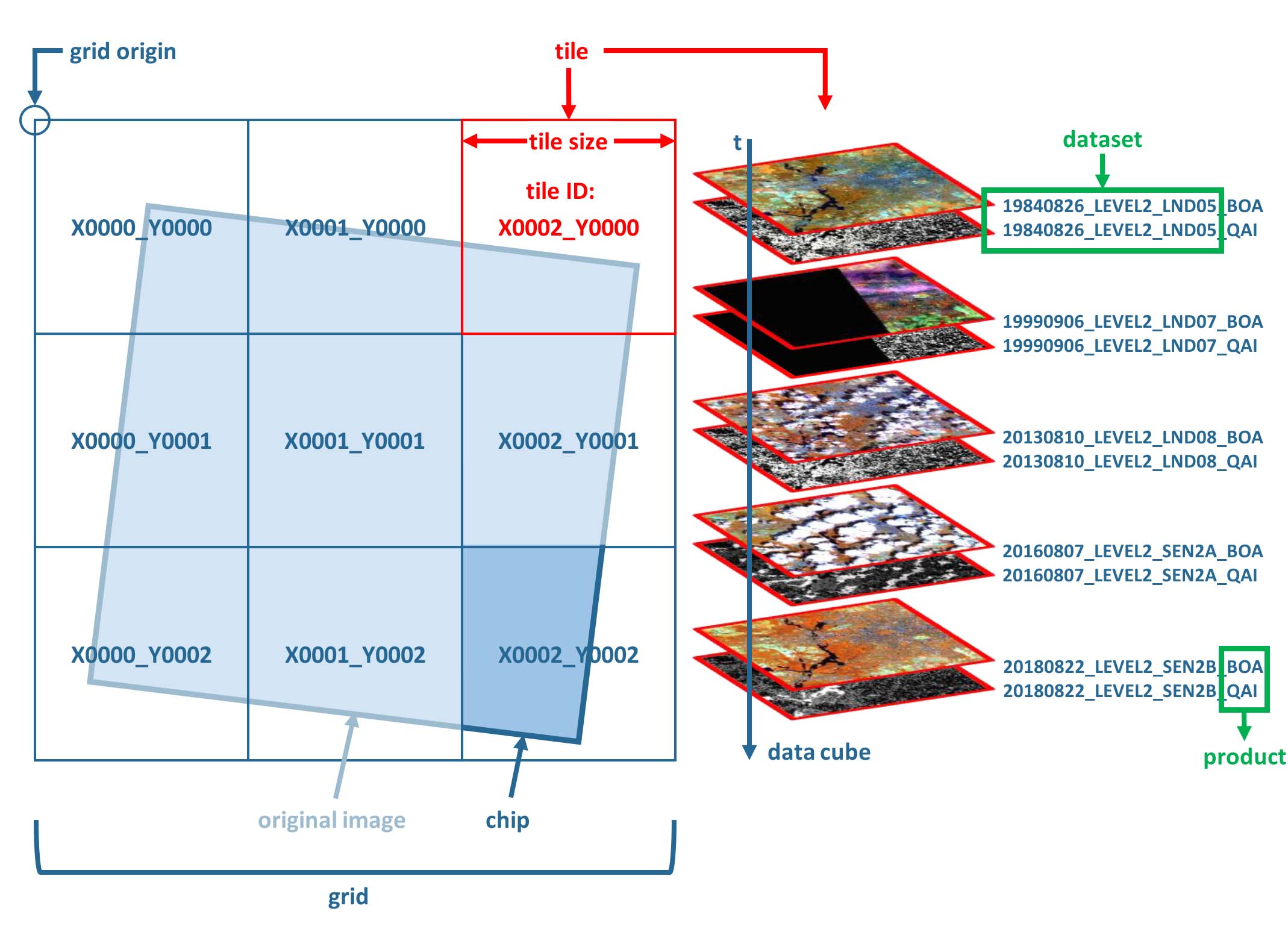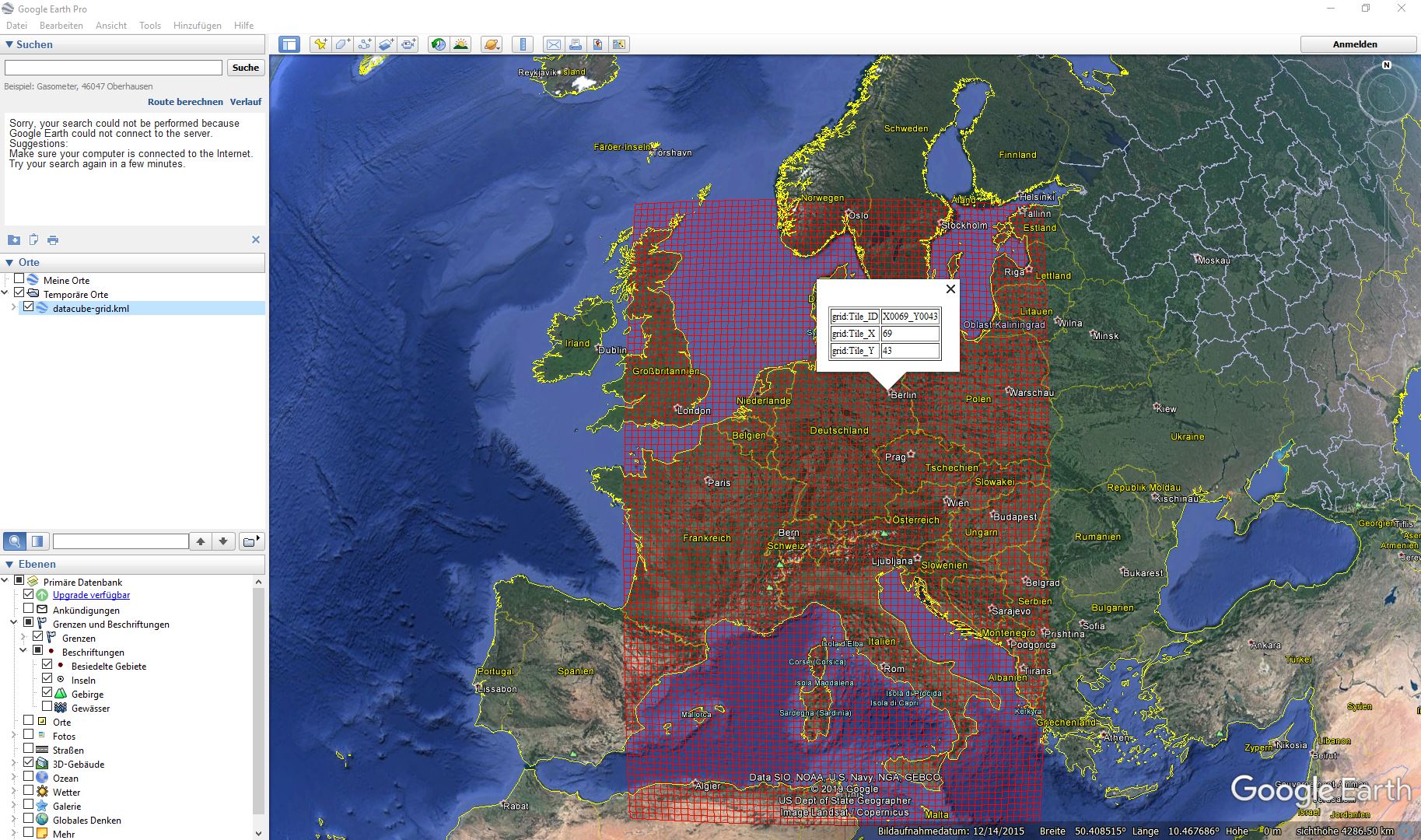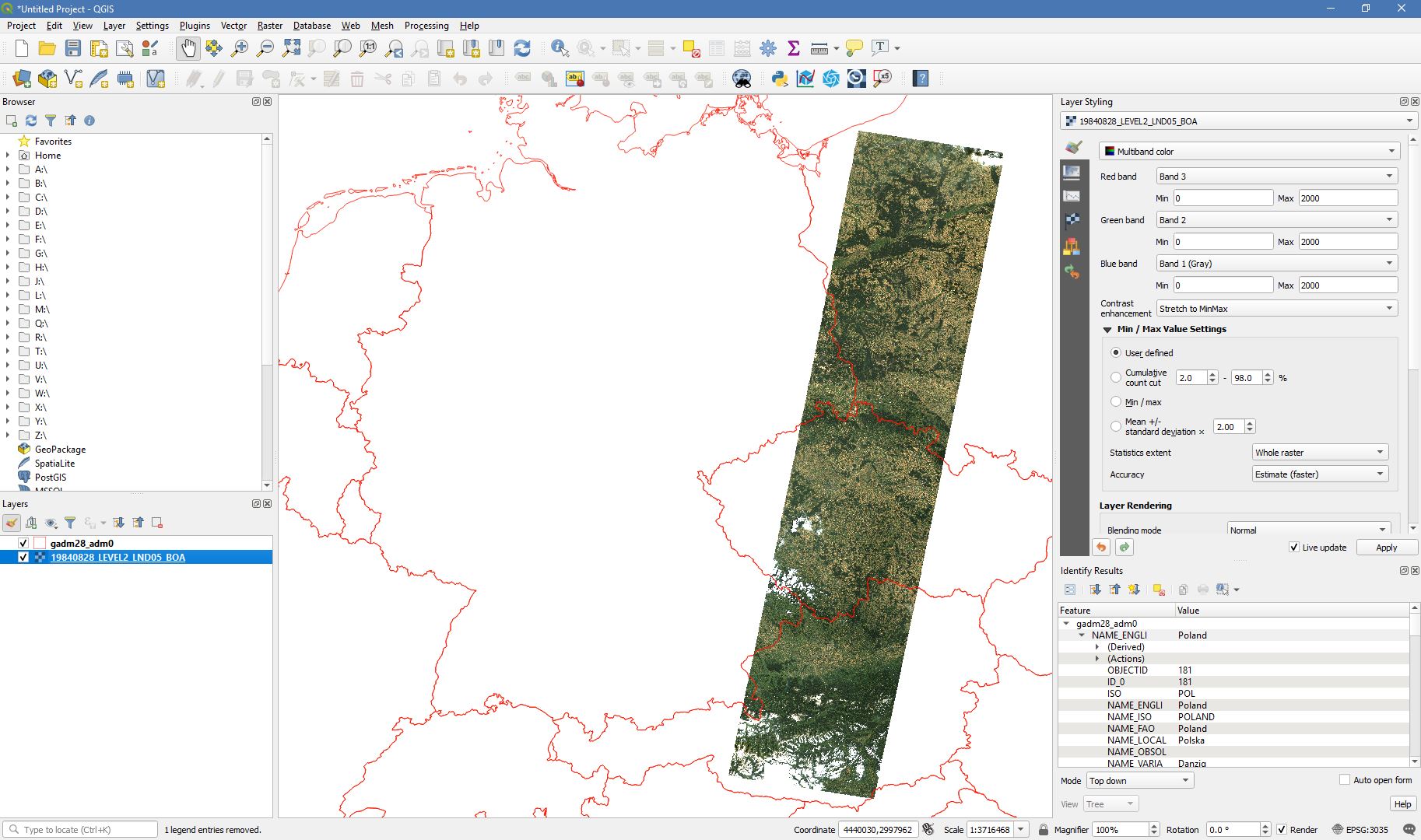The Datacube
How to handle cubed data
This tutorial explains what a datacube is, how it is parameterized, how you can find a POI, how to visualize the tiling grid, and how to conveniently display cubed data.
Info
This tutorial uses FORCE v. 3.0
Background
FORCE makes heavy use of the data cube concept. This includes two main points:
All data are in the same coordinate system, which should be valid for a large regional extent (e.g. a continental projection).
The data are organized in regular, non-overlapping tiles.

Overview of the datacube concept in FORCE.
Definitions
The grid is the regular spatial subdivision of the land surface in the target coordinate system.
The grid origin is the location, where the tile numbering starts with zero. Tile numbers increase toward the South and East. Although not recommended, negative tile numbers may be present if the tile origin is not North–West of the study area.
The tile is one entity of the grid, i.e. a grid cell with a unique tile identifier, e.g. X0003_Y0002. The tile is stationary, i.e. it always covers the same extent on the land surface.
The tile size is defined in target coordinate system units (most commonly in meters). Tiles are square.
Each original image is partitioned into several chips, i.e. any original image is intersected with the grid and then tiled into chips.
Chips are grouped in datasets, which group data according to acquisition date and sensor.
The data cube groups all datasets within a tile in a time-ordered manner. The data cube may contain data from several sensors and different resolutions. Thus, the pixel size is allowed to vary, but the tile extent stays fixed. The tile size must be a multiple of the resolutions. Other data like features or auxiliary data are also permitted in the data cube (e.g. DEM or climate variables).
The data cube concept allows for non-redundant data storage and efficient data access, as well as simplified extraction of data and information.
How to define the datacube parameters?
When generating Level 2 ARD data with FORCE L2PS, you need to define the datacube in the parameter file.
Empty parameter files can be generated with force-parameter
DO_REPROJindicates whether the images should be reprojected to the target coordinate system - or stay in their original UTM projection.DO_TILEindicates whether the images should be tiled to chips that intersect with the grid system - or stay in the original reference system (WRS-2/MGRS).PROJECTIONdefines the target coordinate system. This projection should ideally be valid for a large geographic extent. The projection needs to given as “WKT” string. You can verify your projection (and convert to WKT from another format) usinggdalsrsinfo(see below). If this fails, you need to fix the projection - otherwise FORCE L2PS will likely fail, too.ORIGIN_LATandORIGIN_LONare the origin coordinates of the grid system in decimal degree. The upper left corner of tile X0000_Y0000 represents this point. It is a good choice to use a coordinate that is North-West of your study area – to avoid negative tile numbers.TILE_SIZEis the tile size (in target units, commonly in meters). Tiles are square.BLOCK_SIZEis the block size (in target units, commonly in meters) of the image chips. Blocks are stripes, i.e. they are as wide as the tile and as high as specified here. The blocks represent the internal structure of the GeoTiffs, and represent the primary processing unit of the force-higher-level routines.
Two default projection / grid systems are predefined in FORCE.
They can be specified via the PROJECTION parameter instead of giving a WKT string.
The predefined options have their own settings for ORIGIN_LAT, ORIGIN_LON, TILE_SIZE, and BLOCK_SIZE, thus the values given in the parameterfile will be ignored.
EQUI7 consists of 7 Equi-Distant, continental projections with a tile size of 100km.
GLANCE7 consists of 7 Equal-Area, continental projections, with a tile size of 150km.
One datacube will be generated for each continent.
Warning
If you are not using the datacube options, i.e. DO_REPROJ = FALSE or DO_TILE = FALSE, you are running into a DEAD END for FORCE.
In this case, the data cannot be further processed or analysed with any higher level FORCE functionality…
How to validate the projection?
GDAL has a built-in projection conversion/validation tool:
gdalsrsinfo -v 'PROJCS["ETRS89 / LAEA Europe",GEOGCS["ETRS89",DATUM["European_Terrestrial_Reference_System_1989",SPHEROID["GRS 1980",6378137,298.257222101,AUTHORITY["EPSG","7019"]],TOWGS84[0,0,0,0,0,0,0],AUTHORITY["EPSG","6258"]],PRIMEM["Greenwich",0,AUTHORITY["EPSG","8901"]],UNIT["degree",0.0174532925199433,AUTHORITY["EPSG","9122"]],AUTHORITY["EPSG","4258"]],PROJECTION["Lambert_Azimuthal_Equal_Area"],PARAMETER["latitude_of_center",52],PARAMETER["longitude_of_center",10],PARAMETER["false_easting",4321000],PARAMETER["false_northing",3210000],UNIT["metre",1,AUTHORITY["EPSG","9001"]],AUTHORITY["EPSG","3035"]]'
Validate Succeeds
PROJ.4 : '+proj=laea +lat_0=52 +lon_0=10 +x_0=4321000 +y_0=3210000 +ellps=GRS80 +towgs84=0,0,0,0,0,0,0 +units=m +no_defs '
OGC WKT :
PROJCS["ETRS89 / LAEA Europe",
GEOGCS["ETRS89",
DATUM["European_Terrestrial_Reference_System_1989",
SPHEROID["GRS 1980",6378137,298.257222101,
AUTHORITY["EPSG","7019"]],
TOWGS84[0,0,0,0,0,0,0],
AUTHORITY["EPSG","6258"]],
PRIMEM["Greenwich",0,
AUTHORITY["EPSG","8901"]],
UNIT["degree",0.0174532925199433,
AUTHORITY["EPSG","9122"]],
AUTHORITY["EPSG","4258"]],
PROJECTION["Lambert_Azimuthal_Equal_Area"],
PARAMETER["latitude_of_center",52],
PARAMETER["longitude_of_center",10],
PARAMETER["false_easting",4321000],
PARAMETER["false_northing",3210000],
UNIT["metre",1,
AUTHORITY["EPSG","9001"]],
AUTHORITY["EPSG","3035"]]
Where is the datacube definition stored?
At the top level of the generated datacube, a text file will be generated (datacube-definition.prj).
This file is key for all FORCE higher-level functionality.
Each higher-level module will save a copy of this file in the corresponding output directory.
If this file is not present, the tools will fail.
Therefore, do not modify, move, or delete this file.
This file contains the datacube definition as defined above.
projection in WKT
grid origin, longitude
grid origin, latitude
grid origin, x-coordinate in projection
grid origin, y-coordinate in projection
tile size in projection units
block size in projection units
cat /data/Dagobah/edc/level2/datacube-definition.prj
PROJCS["ETRS89 / LAEA Europe",GEOGCS["ETRS89",DATUM["European_Terrestrial_Reference_System_1989",SPHEROID["GRS 1980",6378137,298.257222101,AUTHORITY["EPSG","7019"]],TOWGS84[0,0,0,0,0,0,0],AUTHORITY["EPSG","6258"]],PRIMEM["Greenwich",0,AUTHORITY["EPSG","8901"]],UNIT["degree",0.0174532925199433,AUTHORITY["EPSG","9122"]],AUTHORITY["EPSG","4258"]],PROJECTION["Lambert_Azimuthal_Equal_Area"],PARAMETER["latitude_of_center",52],PARAMETER["longitude_of_center",10],PARAMETER["false_easting",4321000],PARAMETER["false_northing",3210000],UNIT["metre",1,AUTHORITY["EPSG","9001"]],AUTHORITY["EPSG","3035"]]
-25.000000
60.000000
2456026.250000
4574919.500000
30000.000000
3000.0000000
Note
In some rare circumstances, you might need to generate this file on your own.
However, this only applies if - for any reason - you skip the Level 2 processing (e.g. if you only want to work with external features, or trick FORCE into using external ARD datasets).
How is the datacube organized?
In practice, the tiles are directories in the file system, and each chip represents one file.
ls /data/Dagobah/edc/level2 | tail
X0134_Y0095
X0134_Y0096
X0134_Y0097
X0134_Y0098
X0134_Y0099
X0135_Y0095
X0135_Y0096
X0135_Y0097
X0135_Y0098
X0135_Y0099
ls /data/Dagobah/edc/level2/X0134_Y0097/*.tif | tail
/data/Dagobah/edc/level2/X0134_Y0097/20181225_LEVEL2_SEN2A_BOA.tif
/data/Dagobah/edc/level2/X0134_Y0097/20181225_LEVEL2_SEN2A_CLD.tif
/data/Dagobah/edc/level2/X0134_Y0097/20181225_LEVEL2_SEN2A_HOT.tif
/data/Dagobah/edc/level2/X0134_Y0097/20181225_LEVEL2_SEN2A_QAI.tif
/data/Dagobah/edc/level2/X0134_Y0097/20181225_LEVEL2_SEN2A_VZN.tif
/data/Dagobah/edc/level2/X0134_Y0097/20181230_LEVEL2_SEN2B_BOA.tif
/data/Dagobah/edc/level2/X0134_Y0097/20181230_LEVEL2_SEN2B_CLD.tif
/data/Dagobah/edc/level2/X0134_Y0097/20181230_LEVEL2_SEN2B_HOT.tif
/data/Dagobah/edc/level2/X0134_Y0097/20181230_LEVEL2_SEN2B_QAI.tif
/data/Dagobah/edc/level2/X0134_Y0097/20181230_LEVEL2_SEN2B_VZN.tif
Within the tile, FORCE semantically groups files into datasets if they have the same sensor and date (e.g. multiple products like Bottom-of-Atmosphere reflectance BOA and Quality Assurance Information QAI).
ls /data/Dagobah/edc/level2/X0134_Y0097/20181225_LEVEL2_SEN2A_*.tif
/data/Dagobah/edc/level2/X0134_Y0097/20181225_LEVEL2_SEN2A_BOA.tif
/data/Dagobah/edc/level2/X0134_Y0097/20181225_LEVEL2_SEN2A_CLD.tif
/data/Dagobah/edc/level2/X0134_Y0097/20181225_LEVEL2_SEN2A_HOT.tif
/data/Dagobah/edc/level2/X0134_Y0097/20181225_LEVEL2_SEN2A_QAI.tif
/data/Dagobah/edc/level2/X0134_Y0097/20181225_LEVEL2_SEN2A_VZN.tif
It is important to note that chips in different tiles have the same filename, thus they can easily be mosaicked.
ls /data/Dagobah/edc/level2/X*/20181225_LEVEL2_SEN2A_BOA.tif | wc -l
49
ls /data/Dagobah/edc/level2/X*/20181225_LEVEL2_SEN2A_BOA.tif | tail
/data/Dagobah/edc/level2/X0133_Y0100/20181225_LEVEL2_SEN2A_BOA.tif
/data/Dagobah/edc/level2/X0134_Y0096/20181225_LEVEL2_SEN2A_BOA.tif
/data/Dagobah/edc/level2/X0134_Y0097/20181225_LEVEL2_SEN2A_BOA.tif
/data/Dagobah/edc/level2/X0134_Y0098/20181225_LEVEL2_SEN2A_BOA.tif
/data/Dagobah/edc/level2/X0134_Y0099/20181225_LEVEL2_SEN2A_BOA.tif
/data/Dagobah/edc/level2/X0135_Y0095/20181225_LEVEL2_SEN2A_BOA.tif
/data/Dagobah/edc/level2/X0135_Y0096/20181225_LEVEL2_SEN2A_BOA.tif
/data/Dagobah/edc/level2/X0135_Y0097/20181225_LEVEL2_SEN2A_BOA.tif
/data/Dagobah/edc/level2/X0135_Y0098/20181225_LEVEL2_SEN2A_BOA.tif
/data/Dagobah/edc/level2/X0135_Y0099/20181225_LEVEL2_SEN2A_BOA.tif
How do I find a POI?
Given any geographic coordinate, the computation of the corresponding tile is pretty straightforward.
Convert the geographic coordinate \((\lambda,\phi)\) to the projected coordinate \((X,Y)\)
Given the tile size \(t_\text{s}\) and the grid origin in projected coordinates \((X_\text{O},Y_\text{O})\), the tile ID can be computed as
With some more math, you can also compute the exact pixel.
However, there is also a FORCE program that relieves you from doing this on your own:
force-tile-finder
usage: force-tile-finder datacube lon lat res
force-tile-finder /data/Dagobah/edc/level2 13.404194 52.502889 10
Point { LON/LAT (13.40,52.50) | X/Y (4552071.50,3271363.25) }
is in tile X0069_Y0043 at pixel 2604/1355
Another useful FORCE program can generate a vector file (shapefile or kml) for convenient display of the tiles.
force-tabulate-grid
usage: force-tabulate-grid datacube bottom top left right format
format: shp or kml
force-tabulate-grid /data/Dagobah/edc/level2 35 60 0 20 kml
/data/Dagobah/edc/level2/datacube-grid.kml
The grid can easily be loaded in GoogleEarth or any GIS. The attribute table contains the tile ID.

Exported grid loaded in Google Earth
How to visualize data for a large extent more conveniently?
Whenever you use a FORCE routine, cubed data will be generated. It is a bit cumbersome to display such data for a large extent without some further treatment. The following recipe can be used for any cubed FORCE data - irrespective of processing level.
Lucky us, the GDAL virtual format represents an ideal concept for this. With VRTs, mosaicks of cubed data can be generated without physically copying the data. The VRT is basically a text file in xml-Format, which both holds (relative) links to the original data and the rules to assemble the mosaic on-the-fly. FORCE comes with a tool to generate such mosaics:
force-mosaic
Usage: force-mosaic tiled-archive
force-mosaic /data/Dagobah/edc/level2
force-mosaic searches for image files in the datacube, and mosaics all files with the same basename.
The mosaics are stored in the mosaic subdirectory.
ls /data/Dagobah/edc/level2/mosaic | head
19840328_LEVEL2_LND05_BOA.vrt
19840328_LEVEL2_LND05_CLD.vrt
19840328_LEVEL2_LND05_HOT.vrt
19840328_LEVEL2_LND05_QAI.vrt
19840328_LEVEL2_LND05_VZN.vrt
19840409_LEVEL2_LND05_BOA.vrt
19840409_LEVEL2_LND05_CLD.vrt
19840409_LEVEL2_LND05_HOT.vrt
19840409_LEVEL2_LND05_QAI.vrt
19840409_LEVEL2_LND05_VZN.vrt
To speed up visualization, pyramids might be generated for the VRT files. This significantly increases loading and response times for visualization. However, pyramid layers are basically copies of the original data at reduced resolution, and as such, they consume some disc space. Consider from case to case whether fast display merits the excess disc usage. FORCE comes with a tool to generate pyramids:
force-pyramid
Usage: force-pyramid file
Pyramids for one file can be generated with:
force-pyramid /data/Dagobah/edc/level2/mosaic/19840828_LEVEL2_LND05_BOA.vrt
/data/Dagobah/edc/level2/mosaic/19840828_LEVEL2_LND05_BOA.vrt
computing pyramids for 19840828_LEVEL2_LND05_BOA.vrt
Practically, a DEFLATE compressed overview image will be stored next to the VRT:
ls /data/Dagobah/edc/level2/mosaic/19840828_LEVEL2_LND05_BOA*
/data/Dagobah/edc/level2/mosaic/19840828_LEVEL2_LND05_BOA.vrt
/data/Dagobah/edc/level2/mosaic/19840828_LEVEL2_LND05_BOA.vrt.ovr
Pyramids for all VRT mosaics can be parallely generated with:
ls /data/Dagobah/edc/level2/mosaic/*.vrt | parallel force-pyramid {}
Any modern software based on GDAL (e.g. QGIS) is able to display VRTs, and can also handle the attached pyramid layers. Mosaicking is done on-the-fly, data outside of the display extent are not loaded.

VRT mosaic loaded in QGIS
|
This tutorial was written by David Frantz, main developer of FORCE, postdoc at EOL. Views are his own. |
EO, ARD, Data Science, Open Science |
|
